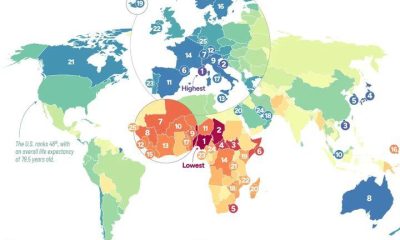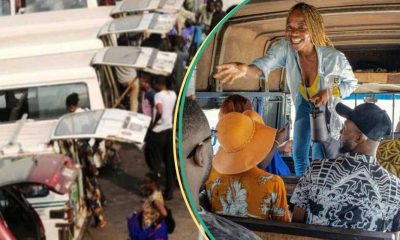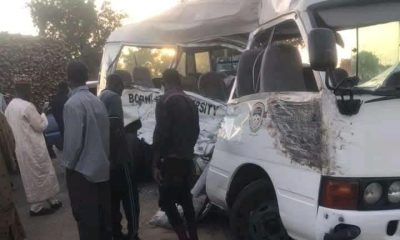Comments and Issues
With COVID-19, we all should be humanitarians
Published
5 years agoon
By
Editor
By Dienne Keita
It is commonplace to see on the pages of newspapers, TVs and also social media humanitarians cladded in jackets bearing descriptive insignia, sometimes with vehicles conveying relief materials and other essential items to those who are extremely vulnerable, caught up in a war or crisis, displaced and in need of humanitarian interventions. These images have become normalized in homes, offices and on the news due to the not too infrequent effervescent nature of global crisis, natural disasters, conflicts, health emergencies amongst others, in need of urgent international response, which the United Nations, an international organisation founded in 1945, is obliged to take action on as contained in its Charter.
Undoubtedly, the UN has been able to carry out these objectives with the help of a dedicated workforce whose impact transcends the walls of their offices to different countries and ultimately to the end beneficiaries –the citizenry. But while at this, a substantial percentage of this workforce, due to the nature of their job are susceptible to harsh climate, environment, dangerous and life threatening situations.
I have a personal connect with this. I was born on 19 August, which happens to be the same day a terrible bomb blast killed United Nations staff in Bagdad, Iraq. A very good friend was feared injured and despite being terribly wounded, she moved on with her life.
In commemoration of that day, 19 August has been set aside as World Humanitarian Day to celebrate the people at the forefront of unbelievable situations around the world.
Across no fewer than 59 countries this year, aid workers and frontline responders are breasting insecurity, disasters, and Covid-19 pandemic to bring help and support to millions of people. In 2019, 483 aid workers were attacked with 125 killed, 234 wounded and 124 kidnapped in a total of 277 separate incidents.
To put it into perspective, earlier this year, precisely 18 January, non-state armed groups attacked the humanitarian hub in Ngala, Borno state, North East Nigeria, burning an entire section of the facility where five UN staff were staying, as well as a vehicle used in aid deliveries. Although there were no causalities, aid workers are still brave enough to continue work in the region, ensuring that relief items and lifesaving interventions gets to millions of refugees and internally displaced persons.
On August 9, unidentified gunmen on motorbikes killed seven aid workers and a tourist guide who were visiting a wildlife reserve in Niger Republic’s Tillabéri region. The aid workers have been working to support the people of Niger facing hardship, hunger and poverty in their quest to support humanity.
The humanitarian space as arena is a totally different turf whose dimensions cannot be comprehensively captured in books, reports and briefs. Aid workers, like those they are trying to help, are often exposed to grave risks and dangers that makes one wonder what drives their resilience other than good spirit, and humanity.
If anything, the statistics prove that their efforts are not in vain. Humanitarians across board have been relentless in ensuring that challenges are not relegated even as COVID-19 pandemic, and its emergency response plan enjoy groundswell of attention.
Importantly, there are quite a few things to note about this year’s celebration. It is an incredible year as the world has become a humanitarian ground, with no country left out. Resilience is challenged everywhere yet medical personnel, psycho-social workers, and volunteers are performing wonders to save lives.
As COVID-19 tears through communities across the globe, particularly in developing and poor countries, many determinants of health, social life, and livelihood are affected. In a pandemic of COVID-19 proportions, the impact on women and girls whether as an aid worker or a person of concern (POCs) are enormous. Some of the challenges faced include, postpartum stress, poor access to contraceptives, domestic violence from intimate partners, period poverty, forced marriages and other attributes that are common identifiers of war torn and hard to reach areas.
In a State of the World Population (SWOP) 2020 report by UNFPA, it was stressed that pandemic-related economic disruptions are increasing the vulnerability of girls to harmful coping mechanisms, including harmful practices such as child marriage, and female genital mutilation. The statistics of girls subjected to female genital mutilation if the pandemic causes a two year delay in female genital mutilation prevention programmes, has been estimated by UNFPA researchers to reach 2 million cases over the next decade. Furthermore, a one-year average delay in interventions to end child marriage could lead to some 7.4 million more child marriages over the next decade that otherwise could have been averted. The report also said there is the tendency for a whopping 5.6 million additional child marriages taking place between 2020 and 2030. What then become of these millions of children and the society without humanitarian interventions? How do they hope for a better live and future?
The impact of child marriage, for instance, eventually has a hyphal connection with the development of a country. Child marriage enables the vicious cycle of poverty and emasculates productivity, with an overbearing impact on the well-being of an economy. In addition to the aforementioned issues of sustainable human development, sexual and reproductive health, and gender-based violence in humanitarian settings, UNFPA has been a pillar of support for nations in the stranglehold of those challenges. The body, while carrying out others of its activities, has supported reproductive health care for women and youth in more than 150 countries where more than 80 per cent of the world’s population reside.
Whichever way one decides to view it, the burden of ensuring that challenges such as the one the world is presently confronting, does not degenerate into anarchy and further worsen the already deplorable global crises landscape, falls on humanitarians. And they come in different shapes and sizes.
Perhaps, one of the best ways to begin is by adhering to COVID-19 safety protocols so that life can return to normalcy even as the world await a vaccine. This invariably will improve access to lifesaving sexual and reproductive kits to indigent women and girls in rural and hard to reach communities, present opportunities to children to hope for a better future amongst others. In doing this, we must embrace a safe place for mutual understanding, trust and tolerance while giving humanitarians the respect that they deserve. We all should see ourselves as humanitarians. As I write this, another crisis emerged and yet other colleagues and families are on the forefront. August 19 is a great day to reflect on one personal responsibilities, to contribute to the world humanitarian day activities right at your own door step. If you want to help, this is the day while respecting social distancing. Whilst, it is a happy birthday for me and my little Diene Makita, I am extending same to the new generation of humanitarian workers around the world.
Dr. Diene Keita,
Assistant Secretary-General, Deputy Executive Director (Programme)
United Nations Population Fund.
Trending

 Editorial Opinion1 week ago
Editorial Opinion1 week agoNot This Nigeria

 Latest1 week ago
Latest1 week agoObasanjo identifies four strategic pillars to tackle Nigeria’s worsening security crisis

 Comments and Issues4 days ago
Comments and Issues4 days agoNigeria’s Life Expectancy as World’s Lowest

 Health4 days ago
Health4 days agoFDA expands probe into COVID-19 vaccine-linked deaths

 News6 days ago
News6 days agoNigeria, China strengthen agricultural ties in Beijing talks

 Latest3 days ago
Latest3 days agoChristmas rush triggers surge in transport fares from Lagos to South-East

 News5 days ago
News5 days agoFoundation commemorates 10th anniversary set to lift Edo indigents economy

 Latest4 days ago
Latest4 days agoEight UNIJOS students, driver killed as trailer crashes into bus

